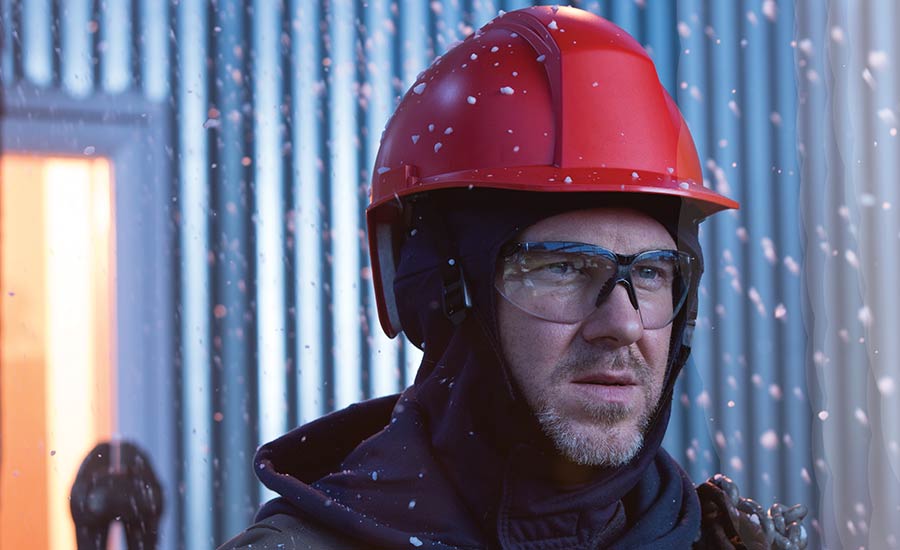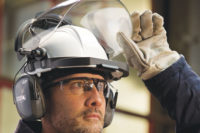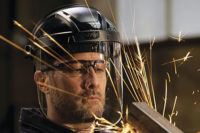Moving and stationary equipment, falling debris, and slippery conditions all pose hazards that can result in head injuries with varying degrees of severity, from mild concussions to comas— even fatalities. Traumatic brain injury (TBI), a common outcome of impact to the head, can cause physical, cognitive, social, emotional, and behavioral effects that may result in short-term or permanent impairment.
Overall, traumatic brain injury is the leading cause of death and disability in children and adults ages 1 to 44, according to the Brain Trauma Foundation (BTF). The top three factors that cause TBI include falls, motor vehicle crashes and being hit or colliding with another object, according to the Centers for Disease Control and Prevention. In TBI, the brain bruises and swells upon impact, limiting blood-flow and depriving tissue of vital oxygen, which can cause irreversible cell death and brain damage, according to the BTF. In addition to these immediate effects, secondary injury often occurs in the hours and days following impact as swelling and bruising evolve. For this reason, symptoms often appear hours or even days later.
Head injuries are still widespread
Despite widespread use of hard hats, occupational head injuries continue to occur at an alarming rate. In 2013, nearly 87,000 nonfatal head injuries requiring at least one day away from work occurred in the U.S., according to the Bureau of Labor Statistics. In the same year, fatal work injuries resulting from slips, trips and falls totalled 724, according to the Bureau. The effects of such injuries can be devastating to employers and workers alike.
OSHA calls for employers to “ensure that each affected employee wears a protective helmet when working in areas where there is a potential for injury to the head from falling objects.” OSHA also requires compliance with the American National Standards Institute (ANSI) Z89.1-2009 standard for Industrial Head Protection, designed to ensure proper performance of hard hats in the event of impact. The standard specifies two levels of protection: ANSI Type I hard hats are required to protect the wearer against impact and penetration of the crown (top) of the head only, while Type II hats are required to protect against both lateral and crown impact. Adoption of Type II hats is on the rise, given growing recognition of their life-saving benefits, but Type I hats are still, by far, the most commonly used type in the U.S.
Protecting the back of the head
One area where Type I hard hats traditionally have not provided ample coverage is the back of the head. Not specified in the ANSI standard, back-of-head protection is vital to anyone working in environments where snowy, slick or icy conditions exist, as well as anywhere moving or stationary objects may strike the rear of the head. Innovations in Type I hard hat design now allow employers to provide increased protection for workers.
High-risk environments
Across the spectrum of Alaskan drilling and pipeline operations, for instance, workers not only work in, but also traverse and drive on frozen or slippery surfaces, increasing the likelihood of slips and falls. Long shifts and extreme cold can lend to worker fatigue and an increased risk of injury from contact with stationary and moving objects.
Another environment where the opportunity for slips and falls prevails is offshore rigs. Here, workers carry out job functions on wet, oily or otherwise slick surfaces among heavy machinery and other equipment.
Construction is one of many more industries where back-of-head hazards are present, from moving vehicles, cranes, and equipment that can strike the back of the head, to slippery or uneven surfaces that pose fall hazards.
Additional coverage
When selecting a hard hat for use among back-of-head hazards, look for a shell design with expanded, low-profile coverage all the way down the back of the skull, not just the upper portion of the wearer’s head. While additional protection is key, make sure the extended shell design does not constrict a worker’s range of motion, especially if bulky clothing or cold weather gear is worn. Because the surface area of the shell increases with extended protection, consider the weight of the hat as well. Selecting a shell that is constructed of durable yet lightweight material can help minimize weight and support all-day comfort for the wearer.
Secure retention
An effective hard hat must fit securely on the head without moving out of place in the event of impact. Be sure to look for a hard hat that offers the wearer multiple adjustment points in the suspension design so that a personalized, secure and comfortable fit can be achieved. Also, look for hard hats with a robust chin strap, which keep the hat in place and ensure comfortable wear; an uncomfortable chin strap is likely to be unfastened, leaving the worker vulnerable to injury. Features such as ergonomically designed ratchets ensure quick and easy tightening and loosening each time the wearer dons and doffs the hat, further promoting a secure, stay-put fit every time.
Suspension’s dual role
Suspension is the internal framework that helps the hat absorb and distribute energy upon impact. Hard hats generally come with four-, six-, or eight-point suspensions; those with more suspension points have a greater ability to spread impact and weight over a wider area. Dispersing impact energy is the suspension’s primary function and can significantly reduce the risk of injury to a worker. A suspension that effectively disperses the weight of the hat offers the added benefit of greater all-day comfort for the wearer. Hard hats featuring a rear foam attenuator will further help absorb impact energy to reduce the risk of injury.
With new advances in hard hat design, outfitting workers in high-risk environments with back-of-head protection is becoming easier. By understanding the latest innovations and what to look for in a hard hat, you can make informed decisions that improve worker safety and ultimately save lives. The benefits of providing hard hats that deliver the utmost in protection and comfort support a productive workforce and a successful culture of safety—and that’s a win in every industry.



